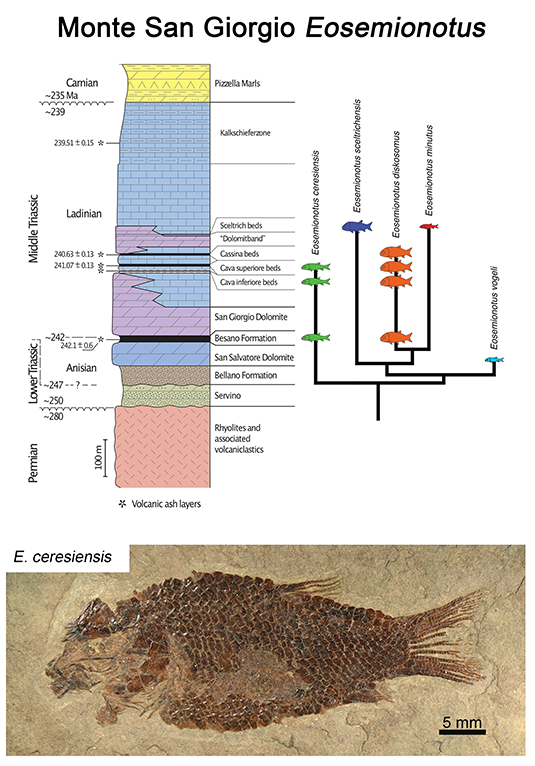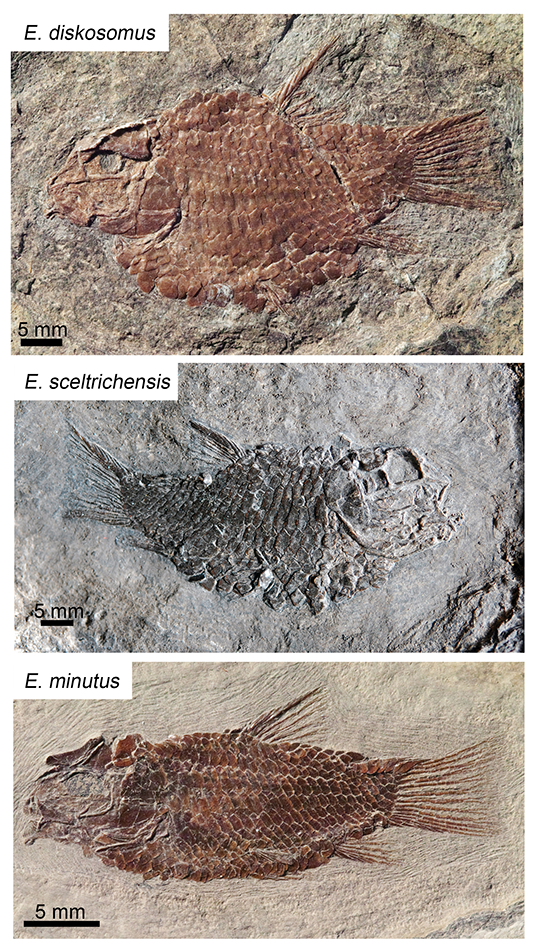Diversification after “Great Dying”
Three new fossil fish species discovered in the Swiss Alps by a team led by LMU paleontologist Adriana López-Arbarello provide new evidence of rapid recovery of life after ‘Great Dying’
28.02.2019
In the history of Earth, life has been frequently challenged by mass extinctions caused by environmental catastrophes. The largest among them, known as the “Great Dying”, took place about 250 million years ago at the Permian-Triassic boundary and led to the disappearance of more than 90% of all marine species. The “Great Dying” was followed by a long period of about 10 million years of unstable environmental conditions and successive waves of extinction. Opportunists organisms known as “disaster taxa” lived during that time, but recovery of life first began with the start of the Middle Triassic Period (around 240 million years ago). “Our finds now provide further evidence that the biosphere recovered astonishingly fast after this disastrous phase in the history of our planet,” explains López-Arbarello. The Monte San Giorgio at Lake Lugano in the Swiss canton of Ticino is the most intensively studied and best-known record of marine life during the Middle Triassic Period thus representing one of the most important windows to the process of life recovery after the largest episode of mass extinction. The outstanding universal value of this paleontological treasure was strengthened by its inscription as one of the UNESCO World Heritage Sites in 2003.


The team led by LMU paleontologist Adriana López-Arbarello has been studying ray-finned fishes from this site since several years. Their research led to the discovery of new species, which serve as signals of well-established ecosystems including specialized organisms capable of developing complex ecological networks. The new fossil fish specimens, which the researchers now report in the online journal Palaeontologia Electronica, represent three previously unknown species of the genus Eosemionotus. These very small ray-finned fishes, which are almost exclusively known from the Middle Triassic, were first discovered in 1906 in the German Muschelkalk of Förderstedt bei Bernsburg, close to Berlin. This first species was named Eosemionotus vogeli and remained the sole evidence of the existence of this fish for almost a century until a second species E. ceresiensis was discovered in 2004 in Monte San Giorgio. The find of several excellently preserved specimens recovered from the Cassina and Sceltrich beds of the Meride Limestone in Monte San Giorgio triggered the new research carried out by the team led by López-Arbarello. “Our studies led not only to the recognition of the three new species E. diskosomus, E. sceltrichensis and E. minutus, but also to the clarification of the phylogenetic relationships of this fish, which have been enigmatic so far,” says López-Arbarello. The detailed anatomical studies show that the five species of Eosemionotus, which are all very small in size, differ from each other on the relative proportions of their bodies, the position of the fins, the morphology of the skull, and the disposition of teeth and scales. “These differences indicate that each species was adapted to different ecological niches, thus demonstrating the existence of dynamic ecosystems at the beginning of the Middle Triassic,” López-Arbarello concludes.
Furthermore, “Our phylogenetic analysis reveals that Eosemionotus is the oldest known member of the extinct family Macrosemiidae. After this origin in the Middle Triassic, macrosemiids were a very successful group of ray-finned fishes during the Mesozoic Era. They diversified and dispersed along the coasts of the ancient Tethys Ocean and died out at the end of the Cretaceous. These fishes belong to a major lineage of ray finned fishes called Ginglymodi, which were one of the most successful groups of vertebrates during the Mesozoic, but, like dinosaurs went almost completely extinct by the end of this Era. However, unlike dinosaurs, which are nowadays represented with roughly 10,000 species of birds, ginglymodians have survived with only seven species, the gars,” says López-Arbarello.
Publication
Taxonomy and phylogeny of Eosemionotus Stolley, 1920 (Neopterygii: Ginglymodi) from the Middle Triassic of Europe.
Adriana López-Arbarello, Toni Bürgin, Heinz Furrer and Rudolf Stockar
Palaeontologia Electronica 2019
For more on López-Arbarello’s research
- Neuer Artenreichtum nach dem Massenaussterben
- Adaptive radiations in the Mesozoic
- Aftermath of a mass extinction
- A hard nut to crack: the Evolution of the armored fishes
- New Species of Fish from the Genus Eosemionotus
Contact

